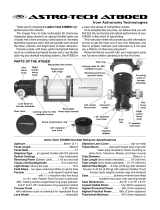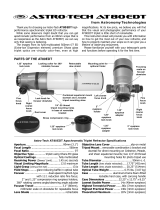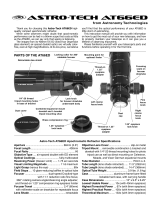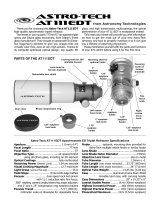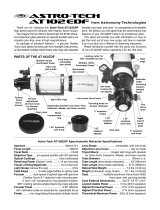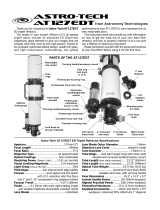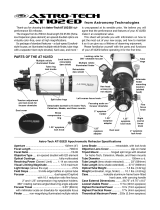Page is loading ...

astro-tech AT80LE
from Astronomy Technologies
Thank you for choosing our Astro-Tech AT80 LE high-
performance apochromatic doublet ED refractor.
Its carbon fiber tube and dew shield are exceptionally
durable, with excellent thermal characteristics. The dew
shield is oversized, with a 124mm o.d. compared to the
80mm lens diameter.
This assures that tube currents, which typically follow
the walls of a telescope tube, will have a minimal effect
on your images as the AT80LE cools down to ambient
temperature. You can begin serious observing with an
AT80LE sooner than you can with an aluminum tube
80mm doublet with a conventional dew shield design.
The images from the AT80LE’s fully-multicoated 480mm
f/6 ED doublet optical system (using premium Ohara glass
and an FPL-53 extra-low dispersion element) are virtually
color-free, even at very high magnifications. We believe
you will find that the visual and photographic performance
of your AT80 LE doublet is little short of remarkable.
This instruction sheet will provide you with information
on how to get the most out of your new refractor, and
how to properly maintain your scope so it can give you a
lifetime of observing enjoyment.
Please familiarize yourself with your telescope’s parts
and functions before operating it for the first time.
Astro-Tech AT 80LE Refractor Specifications
Retractable
dew shield
Lock knob
for focuser
drawtube
90mm split rings,
with 1/4”-20 thread
mounting holes
top and bottom
PARTS OF THE AT80LE
Left coarse
focus knob
Fine
focus
knob
Focusing
scales on
focuser
drawtube
2” eyepiece
lock knob
Dust cover
1.25” eyepiece
lock knob
Brass compression ring
Mounting points for
optional finder
2” eyepiece
holder
1.25”
eyepiece
lock knob
Fine
focus
knob
Right coarse
focus knob
1.25”
eyepiece
adapter
1.25” eyepiece
adapter
Right
coarse
focus
knob
Tension
adjustment
knob for
focuser drawtube
2” eyepiece
lock knob
Dew shield
lock knob
1.25” eyepiece
lock knob
Dust cap
Aperture .............................................. 80mm (3.1”)
Focal Length ...............................................480mm
Focal Ratio ........................................................ f/6
Objective Type...... doublet using Ohara FPL-53 glass
Optical Coatings ........................... fully multicoated
Resolving Power (Dawes’ Limit) ......... 1.45 arc seconds
Visual Limiting Magnitude .............. 12.0 maximum
Light Grasp (versus the eye) ................................ 131x
Field Stops ... 2 glare-reducing baffles in optical tube,
one at front of dew shield
Focuser ............................ dual-speed Crayford-style
with 10:1 reduction ratio fine focus;
2” and 1.25” compression ring eyepiece holders
Focuser Travel ............ 2.9” (74mm), with millimeter
and inch scales on drawtube for repeatable focus
Optical Tube Material .......................... carbon fiber
Optical Tube Diameter ......................... 90mm o. d.
Tube Length (lens shade retracted) ......... 15.5” (394mm)
Tube Length (lens shade extended) .......18.75” (476mm)
Weight (optical tube only) ..................5.15 lbs. (2.34 kg)
Weight (with rings and 1.25” adapter) ...6.55 lbs. (2.98 kg)
Lens Shade ... retractable carbon fiber, with lock knob
Objective Lens Cover .........................slip-on metal
Mounting Rings ............ dual 90mm felt-lined hinged
split rings with 1/4”-20 thread mounting holes
Case ............................. aluminum-frame foam-fitted
lockable hard case, with carrying handle
Case Dimensions ............................. 20” x 7.5” x 9”
Lowest Usable Power ............ 12x (40mm eyepiece)
Highest Terrestrial Power ....... 80x (6mm eyepiece)
Highest Practical Power ........ 160x (3mm eyepiece)
Theoretical Maximum ........... 160x (3mm eyepiece)

astro-tech
www.astronomytechnologies.com
from Astronomy Technologies, 680 24th Avenue SW, Norman, OK 73069
© 2008 by Astronomy Technologies Specifications, features, and descriptions are effective 7/1/2008, but are subject to correction and/or modification without notice and/or obligation.
Your Astro-Tech AT80LE refractor is usable for day and night
viewing, simply by adding a star diagonal and eyepiece. Any brand of
eyepiece can be used, from a 40mm for the lowest useful magnifica-
tion (12x) to a 3mm (160x) for high power use. A 2” compression
ring eyepiece holder on the focuser drawtube and a supplied 1.25”
compression ring eyepiece adapter let you use either a 2” or 1.25”
star diagonal with no other adapter needed.
The focal length of the AT80LE is ideal for low to medium power
wide-angle views of nebulas, open star clusters, large galaxies, and
comets. Crisp and detailed views of the Moon, planets, binary stars,
and globular star clusters are also routine at magnifications of 120x
to 160x when seeing conditions permit.
To calculate the magnification of your telescope and eyepiece com-
bination, divide the telescope focal length in mm by the eyepiece
focal length in mm. For example, a 6mm eyepiece in the AT80LE will
give you a magnification of 80x (480mm/6mm = 80).
Astronomical Observing: The theoretical maximum usable power
available from this telescope is 160x. This requires a 3mm eyepiece
that provides a narrow and quite dim 0.5mm exit pupil. A more prac-
tical maximum magnification for astronomical viewing with the AT80LE
might be 120x, using a 4mm eyepiece. Keep in mind that seeing
conditions play an important role in how high a magnification you can
use on any given night. Only good seeing conditions (clear skies and
calm air) will support viewing at 160x. Under less than ideal condi-
tions, lower powers in the 80x to 120x range provide more consis-
tently usable and pleasing images.
The widest possible field of view with a 1.25” eyepiece is about
3.5°, which can be achieved with a 12x (40mm) Plössl eyepiece.
Fields of view of as much as 5.5° can be achieved with 2” wide field
eyepieces of a similar focal length.
While the AT80LE has not been specifically designed for astro-
photography, it does an outstanding job as a wide-field astrograph
for casual 35mm and CCD imaging. Their are two chrome thumb-
screws under the focuser. The front thumbscrew lets you lock in a
sharp focus for photography. The rear thumbscrew of the pair lets
you adjust the tension on the focuser drawtube to keep heavy 2”
diagonals and eyepieces from accidentally slipping out of focus due
to their weight when the AT80LE is aimed at the zenith.
Terrestrial Observing: The AT80LE works well for daytime
birding, nature studies, sweeping the landscape from the home with
a view, etc. It is also a very good 480mm (9.6x) f/6 telephoto lens for
terrestrial photography. Generally speaking, the maximum usable day-
time power with any terrestrial scope is about 1x per mm of aperture
(80x with a 6mm eyepiece in the AT80LE). Attempts to push the
daytime power beyond 80x often magnify the heat waves, dust, and
“mirage” in our atmosphere to the point where the images become
blurry and unusable. A 20x (24mm) to 53x (9mm) eyepiece is usually
more satisfying for everyday terrestrial use than an 80x.
Mounting the AT80LE: A stable tripod or astronomical mount is
essential for best viewing. The scope is supplied dual hinged 90mm
split rings that will allow you to install your scope on an equatorial
mount of your choice for extended astronomical observing. Adding
an optional Vixen-style dovetail bar to the rings will let you mount
your AT80LE on a suitably-sturdy altazimuth mount for terrestrial ob-
serving and casual grab-and-go backyard astronomy.
Astro-Tech makes just such an altazimuth mount, the exceptionally
stable and highly-reviewed Astro-Tech Voyager. With a 20 lb. payload
capacity, the Voyager can easily support the 6.5 lb. AT80LE. The ad-
justable-height Voyager has automatic-clutch worm gear manual slow
motion controls in both altitude and azimuth to make tracking terres-
trial and astronomical objects smooth and easy.
The AT80LE is light enough to be used on any good quality heavy
duty camera tripod by adding an optional Vixen-style dovetail bar to
the rings. These dovetails generally have a centrally-positioned 1/4”-
20 thread hole that will connect directly to the 1/4”-20 thread mount-
ing bolt on a camera tripod’s pan head.
Optional Astro-Tech Accessories: Astro-Tech makes 1.25” and
2” star diagonals with state-of-the-art 99% reflectivity dielectric coat-
ings that nicely complement the performance of the AT80LE. These
diagonals are available from your Astro-Tech dealer to provide the
maximum possible reflectivity and planetary detail.
An Astro-Tech 45° viewing angle image-erecting 1.25” diagonal is
available for terrestrial observing.
An inexpensive non-magnifying Astro-Tech illuminated multiple
reticle finder is also available. It mounts on the front of the AT80LE
focuser, using either of the pre-drilled mounting holes provided.
Caring for Your Scope Optics: Never store the telescope in a
damp or humid environment. Avoid leaving it in a hot environment
(exposed to direct sunlight on a window sill, in a car trunk, etc.) If
you must store it in high humidity conditions, put a few packets of
desiccant (silica gel or the equivalent, available from most camera
stores) in with the telescope to absorb excess moisture. If not prop-
erly stored in a humid environment, the telescope may develop mil-
dew which can damage the optics.
If dew has formed on the scope after a night of observing, allow
the optics to air dry at room temperature before putting the lens
cover on the scope and storing it away.
If the front lens surface becomes dusty, smeared, or shows finger-
prints or any other surface build-up, clean the lens using the follow-
ing technique. First, gently blow away any surface dust or particles
with a clean air blower (a child’s ear syringe or a photographer’s
camel’s hair brush with attached blower bulb, for example). Using
canned or compressed air is not recommended, as the propellant in
the can may spit out and leave difficult-to-remove deposits on the
lens surface.
Second, moisten a cloth with a few drops of a photographic-quality
optical cleaning solution designed for multicoated camera and bin-
ocular lenses. A well-worn cotton handkerchief works well and Zeiss
and Kodak both make suitable fluids. Do not drip the cleaning fluid
directly on the lens. Use the barely damp (not wet) cloth to gently
wipe the lens surface clean, turning the cloth frequently to always
keep a clean portion of the cloth in contact with the lens. Blot the lens
dry with a dry portion of the cleaning cloth or a separate cloth. Start
with a clean cloth each time cleaning is needed.
Avoid overcleaning your scope. The multicoatings on the lens are
quite hard and durable. However, frequent overzealous cleaning can
scratch the coatings if all the dust particles (which are often tiny
flecks of windborne rock) are not removed before you start pushing a
damp cloth around the lens surface. A few specks of debris on the
lens will not be visible in your images. They are not in the focal plane
and don’t block enough light to measure, let alone be seen. Clean
your optics only when absolutely necessary. If you take proper care
of your scope, cleaning should rarely be needed.
Caring for Your Scope Finish: The clear coat finish on the car-
bon fiber optical tube and dew shield of the AT80LE is extremely
durable, but can potentially become scratched if abrasive cleaners
are used to clean it. The scope can become smudged with finger-
prints during use, but these will not harm the optical tube finish, nor
the anodized finish on the aluminum focuser body and trim rings. A
clean soft cloth slightly dampened with plain water (or a little mois-
ture from your breath and a quick wipe with a clean handkerchief) is
generally enough to remove fingerprints. Avoid abrasive cleaners, harsh
chemical cleaners, or organic solvents like benzene, alcohol, etc., as
these may ruin the finish. They can certainly affect the optical coat-
ings if they accidentally drip or splash on the objective lens.
Never use the telescope in the rain or in conditions where it may
get wet. The telescope is not waterproof. Nightime dew will not harm
the scope, but if the telescope accidentally gets caught in the rain,
immediately wipe off all water using a clean and dry soft cloth. If the
telescope gets totally soaked in water, or submerged, immediately
contact your dealer for service instructions. Do not disassemble or
attempt to repair your telescope yourself, as this violates the terms of
the limited product warranty, and negates any guarantee.
Caution! Never directly view the Sun with your telescope!
Never aim your AT80LE at the Sun without having a professionally-
manufactured solar filter mounted over the objective lens. Viewing
the Sun through the scope without the proper protection for even a
moment may result in permanent severe damage to your eyes, and
can even cause blindness. Contact your Astro-Tech dealer if you are
interested in purchasing a compatible professional solar filter.
/
